Funding and Debt Management
Issuing Longer-Dated Debt
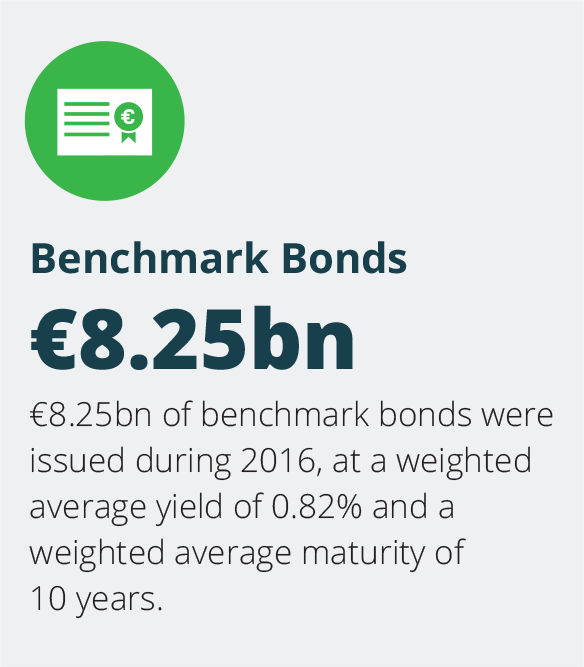
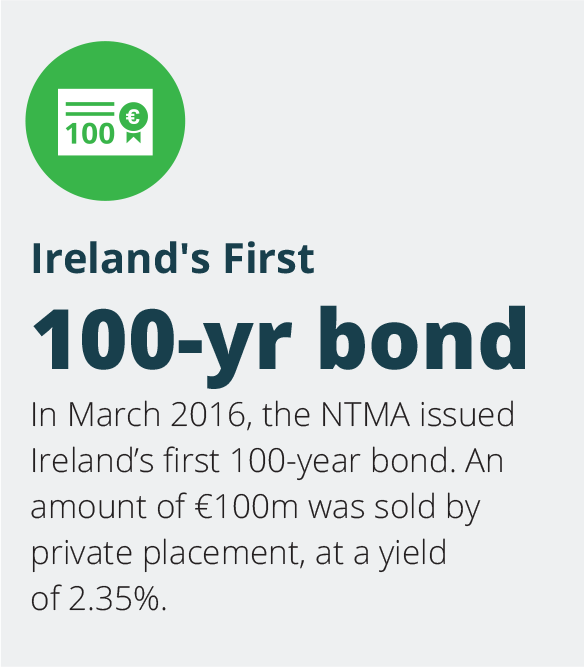
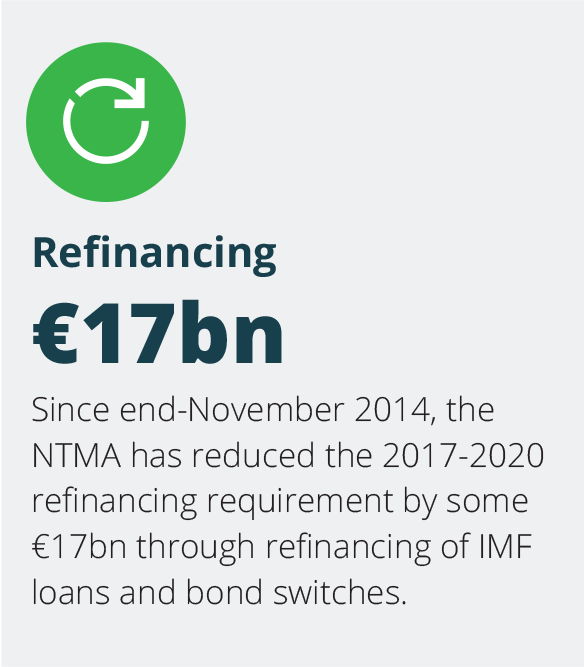
Debt Dynamics Continue to Improve


Gross National Debt at End-2016

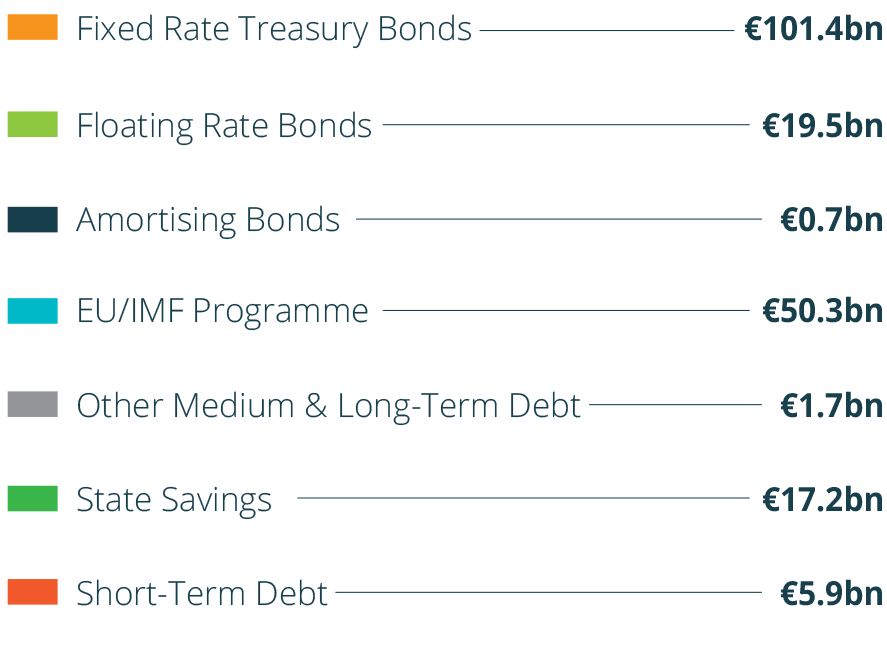
Market Review
Global bond markets experienced significant volatility during 2016. While the ECB quantitative easing measures remained the largest driver of European bond yields, there were several high profile market events throughout the year. These included the UK vote to leave the European Union and the US presidential election. Anticipated changes in the ECB quantitative easing measures and US interest rates also drove this volatility.
The Irish 10-year yield started the year at over 1%. There was a general downward trend in yields over the first half of the year, with a dramatic fall in the week following the UK referendum decision. Ireland’s 10-year yield fell to a low of 0.32% in September 2016 before reverting to 0.74% at year end, this increase being in line with the general trend in European bond yields in the fourth quarter of 2016.
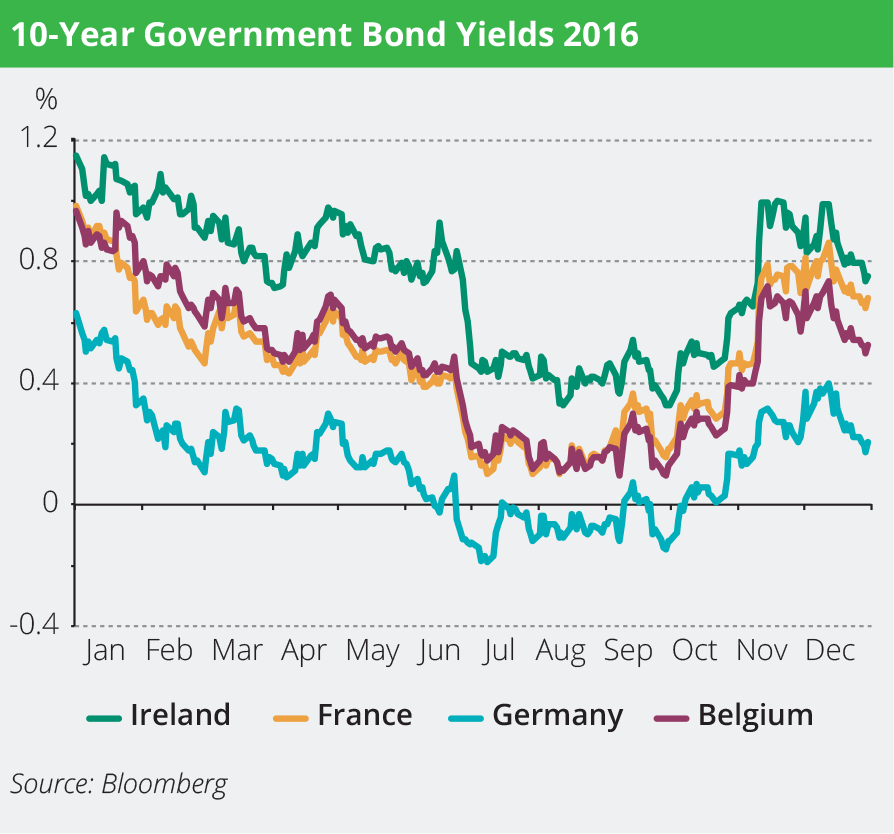
Funding Activity
Long-Term Funding
The NTMA issued €8.25bn of benchmark bonds during 2016. This new issuance had a weighted average yield of 0.82% and a weighted average maturity of 10 years. In addition, Ireland’s first 100-year bond was issued by private placement at a yield of 2.35%.
This issuance contributed further to the NTMA’s strategy of locking in low interest rates and longer maturities while interest rates remain at historically low levels. Over the 2014-2016 period, the NTMA issued €33bn in new bond funding at a weighted average yield of 1.81% and a weighted average maturity of almost 14 years.
The NTMA undertook one bond syndication in 2016, issuing a new 10-year bond in January at a yield of 1.16%. There was strong interest from a broad range of investors, with a total of €3bn being sold. Overseas investors took 88% of the amount issued. Purchases were spread across a range of investor types including fund managers, banks, pension and insurance funds and central banks.
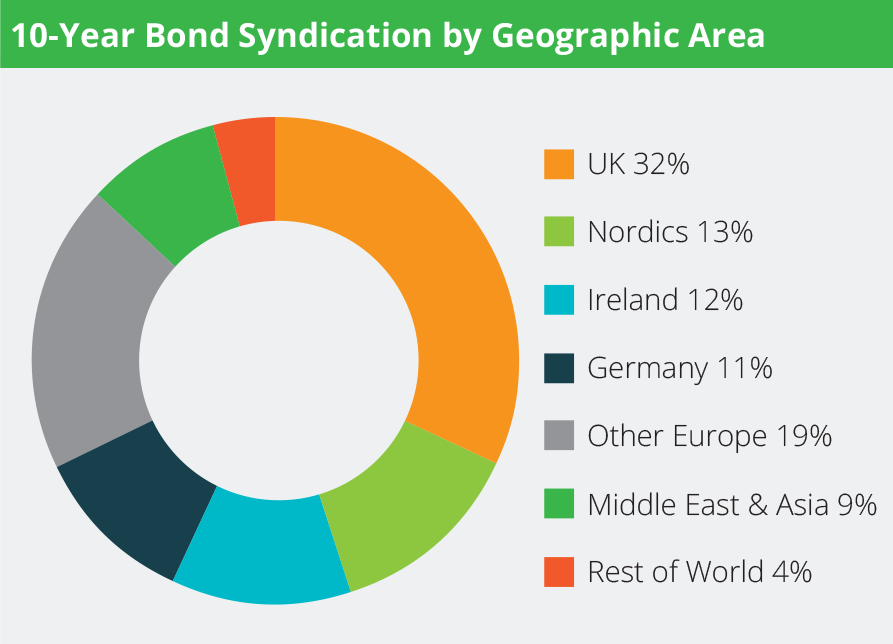
The NTMA also held six bond auctions during the year, raising a total of €5.25bn.
NTMA Bond Auctions 2016
| Auction Date |
Bond Name |
Auction Size €m* |
Yield % |
Bid/ Cover Ratio |
|---|---|---|---|---|
| 11 February | 1% Treasury Bond 2026 | 1,000 | 1.00 | 1.8 |
| 14 April | 1% Treasury Bond 2026 | 750 | 0.82 | 2.4 |
| 12 May | 0.8% Treasury Bond 2022 | 750 | 0.16 | 2.6 |
| 8 September | 1% Treasury Bond 2026 | 1,000 | 0.33 | 2.5 |
| 13 October | 1% Treasury Bond 2026 | 1,000 | 0.50 | 2.0 |
| 3 November | 2.4% Treasury Bond 2030 | 750 | 0.98 | 2.6 |
* excludes non-competitive auctions
In March 2016, the NTMA issued Ireland’s first 100-year bond, through Ireland’s Euro Medium-Term Note Programme. An amount of €100m was sold by private placement, at a yield of 2.35%. This ultra-long maturity was a significant first for Ireland and represented an important vote of confidence in Ireland as a sovereign issuer.
As part of the strategy of locking in low interest rates and protecting against the risk of future upward movements in rates, a total of €3bn of Floating Rate Bonds held by the Central Bank were also bought back and replaced with medium to long-term fixed rate market funding. The total outstanding balance of the Floating Rate Bonds stood at €19.5bn at end-2016, compared with €25.0bn originally issued in 2013.
The NTMA also reduced the volume of short-term debt maturities by buying back approximately €1.9bn of mostly shorter-dated bonds, replacing them with longer-dated bonds.
Short-Term Funding
The NTMA broadened its short-term issuance base by both maturity and volume in 2016.
The NTMA’s Treasury Bill programme continued throughout 2016. Four auctions were held during the year, with two of these in the 12-month maturity space. There was €1bn in Treasury Bills outstanding at end-2016.
The NTMA also maintained Ireland’s Multi–Currency Euro Commercial Paper (ECP) programme in 2016. Total turnover in ECP during the year was €5.5bn and there was €0.3bn outstanding at end-2016.
As a result of the ECB’s expansionary monetary policies and the low interest rate environment, the NTMA was able to issue all Treasury Bills and ECP at negative euro-equivalent interest rates in 2016. Short-term debt was also issued in the form of Exchequer Notes and Central Treasury Notes, mainly to domestic institutional investors.
ECB Quantitative Easing
The ECB introduced quantitative easing measures in March 2015. The programme, whereby national central banks purchase government bonds in the secondary market, is officially known as the Public Sector Purchase Programme (PSPP). Between March 2015 and December 2016, the ECB purchased €1.3 trillion in eurozone public sector bonds. Irish Government bonds accounted for just over €18.5bn of this. The PSPP has been extended until at least December 2017, although at a reduced level from April 2017.
The ECB already held Irish bonds under the Securities Market Programme, which terminated in 2012. The ECB financial statements show nominal holdings of €7.3bn Irish bonds under this programme at end-2016. In addition, the Irish Central Bank held €19.5bn of Floating Rate Bonds at end-2016. These bonds were issued to the Central Bank in exchange for the Promissory Notes provided to IBRC, following IBRC’s liquidation in 2013.
As a result, the Eurosystem is currently the largest holder of Irish Government bonds. At end-2016, at least €45.3bn (37%) of the €121.6bn Irish Government bonds in issuance were held by the Eurosystem1.
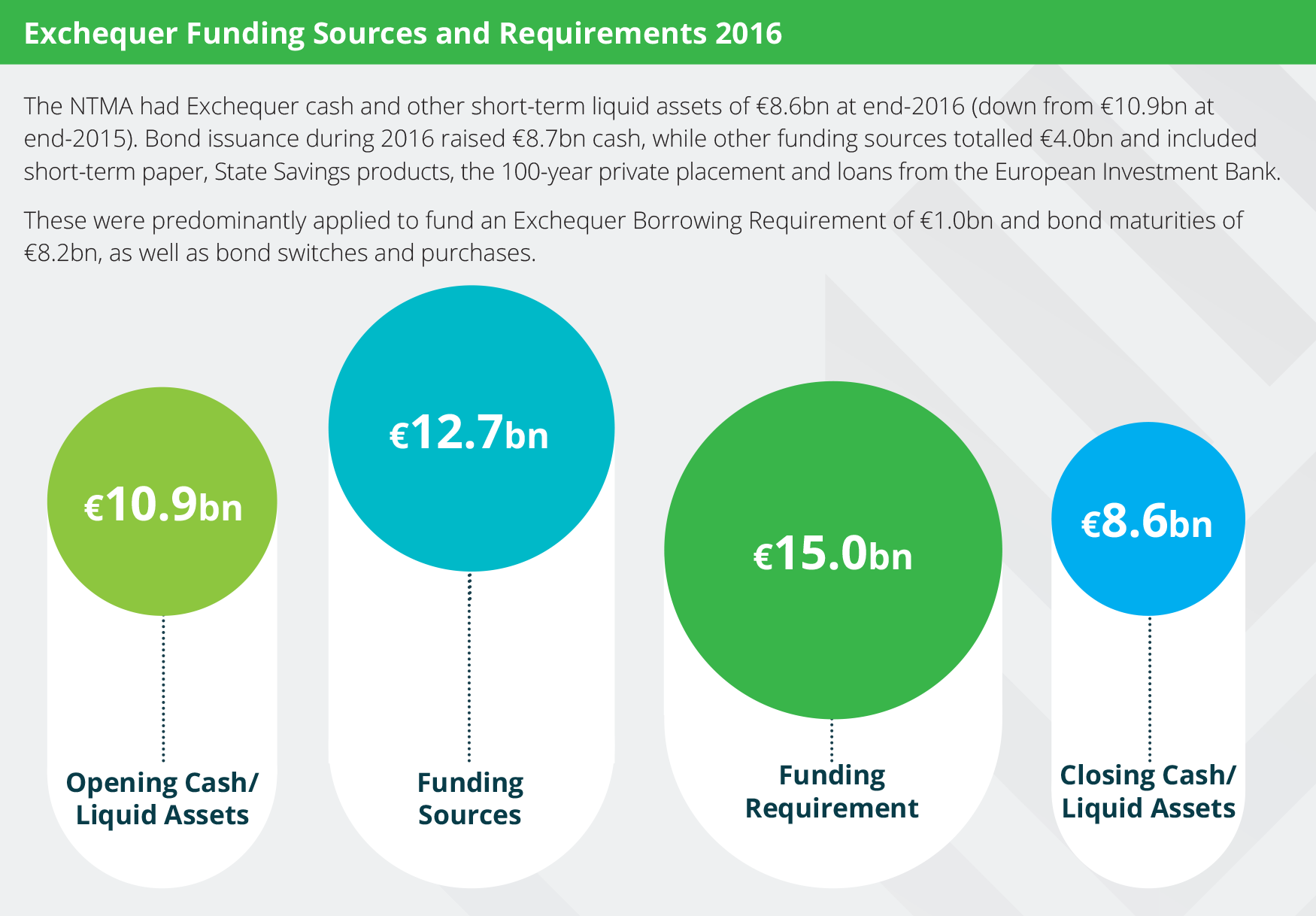
State Savings
State Savings is the brand name applied by the NTMA to the range of Irish Government savings products offered to personal savers. During 2016, there were net inflows of €0.66bn into the State Savings products and at end-2016 the total amount outstanding was €20.1bn.
State Savings Products
| Total Outstanding at End-2016 €m |
Net Inflow/ (Outflow) in 2016 €m |
|
|---|---|---|
| Savings Bonds | 3,747 | (619) |
| National Solidarity Bonds | 4,149 | 704 |
| Savings Certificates | 5,908 | (7) |
| Instalment Savings | 498 | 13 |
| Prize Bonds | 2,892 | 411 |
| Deposit Accounts | 2,921 | 157 |
| Total | 20,115 | 659 |
Figures may not total due to rounding.
In June 2016, the NTMA announced new issues of State Savings products and changes to the interest rates. The current fixed interest rate offerings are detailed below.
| Product |
Fixed Rate Total Return % |
Annual Equivalent Rate % |
|---|---|---|
| 3-Year Savings Bond | 1.0 | 0.33 |
| 4-Year National Solidarity Bond | 2.0 | 0.50 |
| 5-Year Savings Certificate | 5.0 | 0.98 |
| 6-Year Instalment Savings | 5.5 | 0.98 |
| 10-Year National Solidarity Bond | 16.0 | 1.50 |
Changes were made to the variable rates on the Deposit Accounts. These now pay a rate of 0.15%. There were also revisions to the variable rate of interest used to determine the value of the Prize Bonds monthly prize fund. With effect from July 2016 the Prize Bonds prize fund rate is 0.85%. The top weekly prize is €50,000, except in the last weekly draw of every calendar quarter, when the top prize is €1m.
Debt Profile
General Government Debt (GGD) is a measure of the total gross consolidated debt of the State. It is the standard measure used for comparative purposes across the European Union.
National Debt is the net debt incurred by the Exchequer after taking account of cash balances and other financial assets. The primary component of General Government Debt is Gross National Debt – that is the National Debt before netting off cash and financial assets. The NTMA’s responsibilities relate to the management of the National Debt only.
Composition of General Government Debt at End-2016
| €bn | ||
|---|---|---|
| Government Bonds | 121.6 | |
| Fixed Rate Treasury | 101.4 | |
| Floating Rate | 19.5 | |
| Amortising | 0.7 | |
| EU/IMF Programme Funding | 50.3 | |
| Other Medium and Long-Term Debt | 1.7 | |
| State Savings Schemes* | 17.2 | |
| Short-Term Debt | 5.9 | |
| Gross National Debt | 196.7 | |
| Less Exchequer Cash and other Financial Assets | 11.1 | |
| National Debt | 185.6 | |
| Gross National Debt | 196.7 | |
| General Government Debt Adjustments | 3.8 | |
| General Government Debt | 200.6 |
Figures may not total due to rounding.
* State Savings Schemes also include moneys placed by depositors in the Post Office Savings Bank (POSB) which are not an explicit component of the National Debt. These funds are mainly lent to the Exchequer as short-term advances and through the purchase of Irish Government Bonds. Taking into account the POSB Deposits, total State Savings outstanding were €20.1bn at end-2016.
Source: NTMA and Central Statistics Office
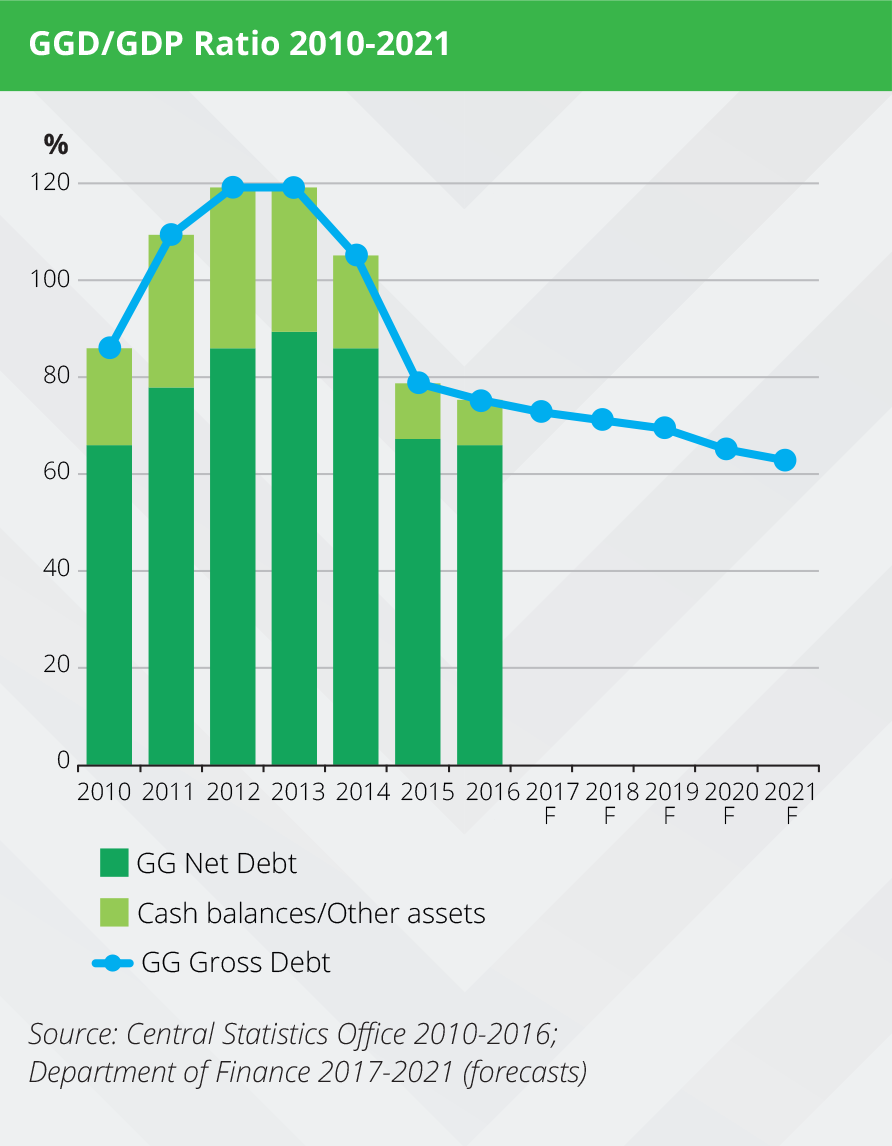
Ireland’s GGD at end-2016 was just over €200bn or 75% of GDP. Although the absolute level of debt remains high, the GGD/GDP ratio has fallen significantly since its year-end 2012/2013 peak of almost 120%, primarily as a result of a sharp rise in GDP. In particular, Ireland’s 2015 GDP figure was highly affected by the activities of multinational companies. Nonetheless, underlying economic activity remains strong.
GGD is a gross measure which does not allow for the netting off of cash balances and other financial assets. However, the CSO produces an estimate of General Government Net Debt which, at end-2016, stood at €175bn or 66% of GDP. The financial assets of €25bn netted of for this purpose include ISIF cash and non-equity investments as well as Exchequer cash and financial assets. They exclude the Government’s equity stakes in the Irish banking sector, most notably AIB.
The significant changes in Ireland’s GDP figures due to the activities of multinational companies make the ratio of debt to GDP less reliable as an indicator of sustainability. To achieve debt sustainability, measures of debt servicing capacity should be stabilising or improving.
In that context, it is worth focusing on additional metrics to obtain a clearer picture of Ireland’s debt burden. These include General Government Debt (gross and net) and Interest, as a percentage of General Government Revenue. While debt dynamics are improving, Ireland still suffers from the legacy of the financial crisis, with absolute debt levels and these alternative metrics remaining at elevated levels.
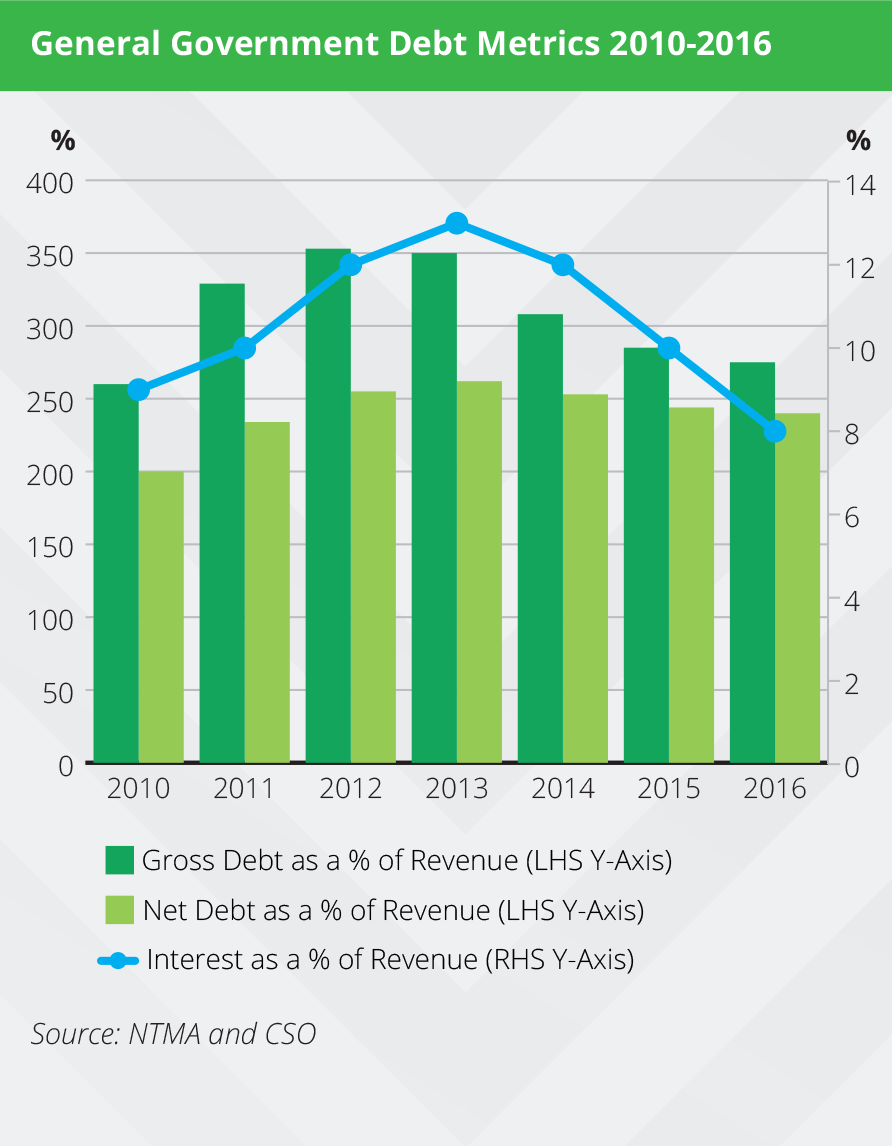
In recent years the NTMA has significantly improved the Exchequer’s debt maturity profile. Since end–November 2014 it has taken steps to reduce the refinancing risk associated with the significant volume of debt maturities arising over the 2017-2020 period. These operations included the early repayment of the bulk of the IMF loan facility and bond purchases and switches, locking in longer maturity debt at low rates. These actions have reduced the 2017-2020 redemptions by close to €17bn.
The weighted average maturity of Ireland’s long-term marketable and official debt is estimated at 11.7 years at end-2016.
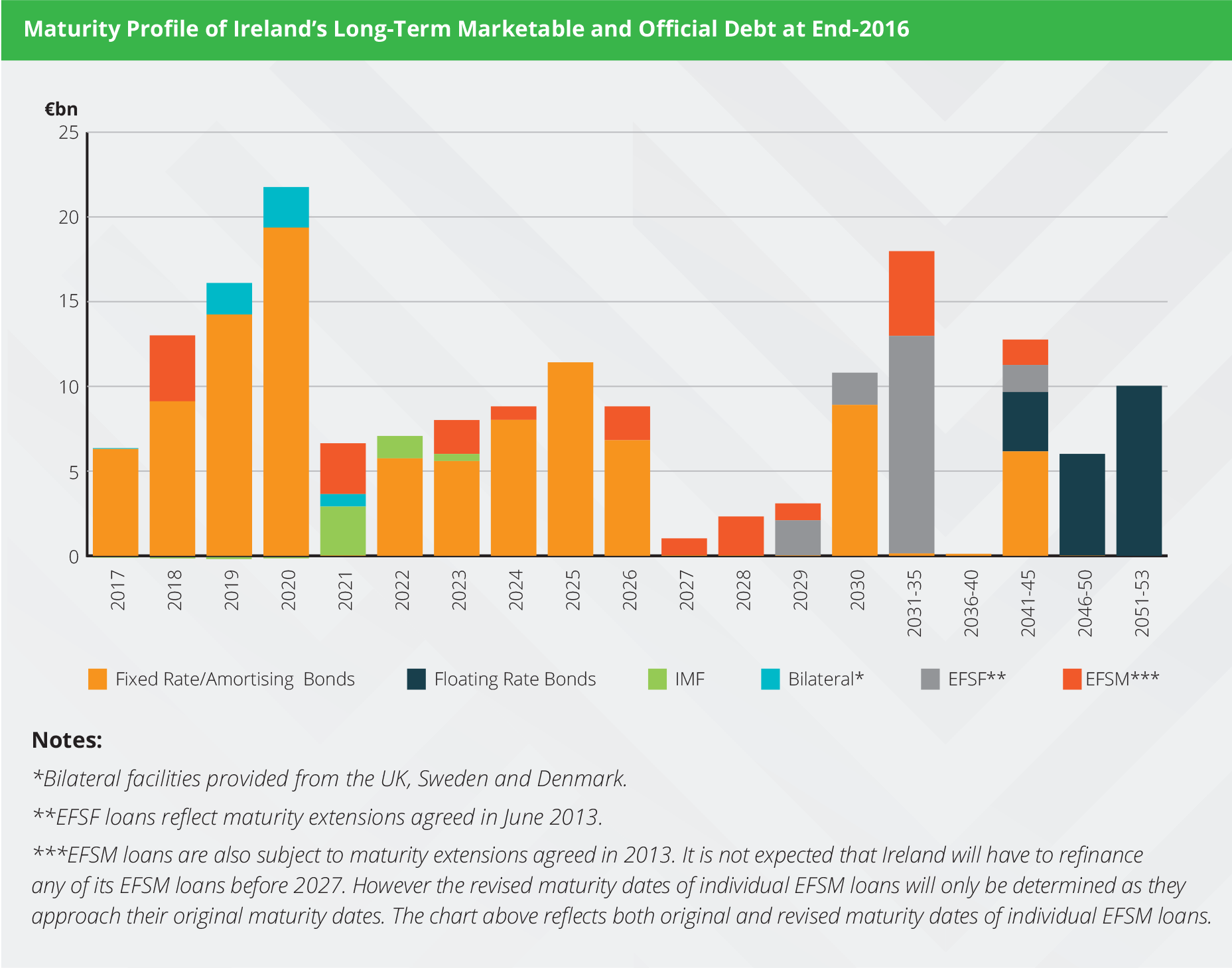
Debt Service Out-turn
The NTMA’s primary debt management objectives are to ensure adequate liquidity for the Exchequer and to optimise debt service costs over the medium term.
The cash interest cost of the National Debt in 2016 was €6,741m, 3.4% below the corresponding figure for 2015 and 9.8% lower than the 2014 peak. The main reason behind the reduction is the early repayment of the bulk of the IMF loan facility over the period December 2014-March 2015 and its replacement with cheaper, long-term, market funding. The 2016 interest bill was 3.5% lower than estimated in Budget 2016 reflecting the favourable interest rate and funding environment evident throughout much of the year.
National Debt interest comprised 14.1% of Exchequer tax revenue in 2016 compared with 15.3% in 2015 and 18.1% in 2014.
Irish Government Bond Market
Ireland’s benchmark bond curve has a range of maturities, extending to 2045.
Irish Government Fixed Rate Treasury Bonds
| Bond |
Maturity Date |
Outstanding End-2016 €m* |
|---|---|---|
| 5.5% Treasury Bond 2017 | 18 October 2017 | 6,227 |
| 4.5% Treasury Bond 2018 | 18 October 2018 | 9,104 |
| 4.4% Treasury Bond 2019 | 18 June 2019 | 7,683 |
| 5.9% Treasury Bond 2019 | 18 October 2019 | 6,540 |
| 4.5% Treasury Bond 2020 | 18 April 2020 | 11,269 |
| 5.0% Treasury Bond 2020 | 18 October 2020 | 8,082 |
| 0.8% Treasury Bond 2022 | 15 March 2022 | 5,728 |
| 3.9% Treasury Bond 2023 | 20 March 2023 | 5,570 |
| 3.4% Treasury Bond 2024 | 18 March 2024 | 7,994 |
| 5.4% Treasury Bond 2025 | 13 March 2025 | 11,390 |
| 1.0% Treasury Bond 2026 | 15 May 2026 | 6,790 |
| 2.4% Treasury Bond 2030 | 15 May 2030 | 8,882 |
| 2.0% Treasury Bond 2045 | 18 February 2045 | 6,099 |
* excluding repos
There were some positive developments for Ireland’s credit rating during 2016. Fitch upgraded the rating to A in February, while Moody’s upgraded to A3 with a positive outlook in May. Ireland has now regained its A category credit rating with all of the major rating agencies.
Ireland’s Sovereign Credit Ratings at End-2016
| Rating Agency |
Long-term Rating |
Short-term Rating |
Outlook |
|---|---|---|---|
| Standard & Poor’s | A+ | A-1 | Stable |
| Moody’s | A3 | P-2 | Positive |
| Fitch Ratings | A | F1 | Stable |
Investor Relations
The NTMA continued its extensive programme of investor relations during 2016. It held roadshows across Europe, Asia, the US and the Middle-East.
The Economics Team participated in over 20 conferences or events over the course of the year. In addition, it produces and regularly updates the NTMA investor presentation pack. This covers topics from economic data to updates on Government funding and the banking sector.
This investor relations programme is important in developing and maintaining long-term relationships with investors. It also provides transparency to the market about Ireland’s macroeconomic situation and the NTMA’s funding plans and keeps investors abreast of Ireland’s credit status.
- Does not include any other Irish Government bonds held by the Eurosystem’s Agreement on Net Financial Assets (ANFA) portfolio.
